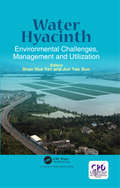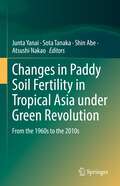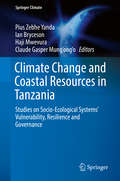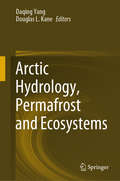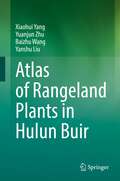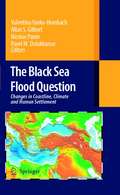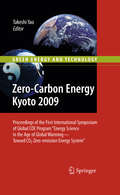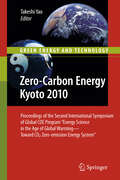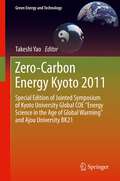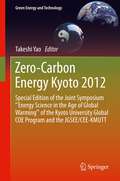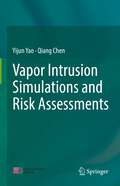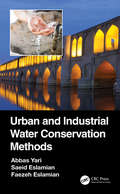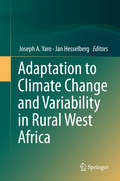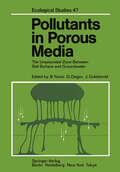- Table View
- List View
Pesticide Law and Compliance Decision Making: A Case Study of Chinese Farmers
by Huiqi YanThis book investigates pesticide compliance in China in order to provide a more comprehensive understanding of compliance and offers some feasible and adaptable suggestions for enhancing the effectiveness of this compliance. It discusses the weak implementation of Chinese laws and rules and emphasizes the necessity and importance of a compliance perspective in China that focuses on why laws are obeyed or broken. It examines how vegetable farmers’ perceptions of amoral calculation affect their pesticide compliance behavior and analyzes how the legitimacy of law is related to compliance to better explain how all the variables interact to shape compliance. It discusses both qualitative and quantitative methods, and uses a large-N qualitative approach, which allows for systematic analysis and in-depth exploration. This book will help readers to understand compliance in developing China by adopting and developing compliance theories which are broadly developed in the West.
Comprehensive Evaluation of Effective Biomass Resource Utilization and Optimal Environmental Policies (SpringerBriefs in Economics)
by Jingjing YanThis book adopts a linear optimization method and introduces a dynamic optimization simulation model for analyzing synthetic environmental policies as endogenous variables in order to improve the environment and provide more biomass energy. The model considers both the total ecological system and the socio-economic situational changes. The purpose of the research is to establish effective utilization methods for biomass resources as well as to coordinate resource reutilization, environmental conservation and economic development, and ultimately to achieve sustainable development of society. By selecting for examination a typical suburb of a major city in China (Miyun County near Beijing), the book improves the simulation model and focuses on the evaluation of water pollutant minimization based on the ecological value of Miyun Reservoir. In the simulation, the author takes into account the specific and unique characteristics of China’s economy and social state in terms of sustained economic growth rate, financial subordination relations and regional environmental policies, all of which differ from the model for Japan. Beyond these innovations, the book introduces two advanced technologies from Japan and China to the study area through simulation with integrated policies, and presents a regional analysis and allocation strategy for these technologies, which have demonstrated impressive operability in practice, in light of the current conditions and limited funds in China.
Water Hyacinth: Environmental Challenges, Management and Utilization
by Shao Hua Yan Jun Yao GuoThe water hyacinth is a disruptive factor in aquatic ecosystem management and ecosystem services, and causes problems in fisheries, transportation waterways, irrigation, hydropower generation, and water resources. To address these concerns, it is necessary to integrate past studies with current research and innovations to identify where the knowledge gap is and to creatively assess and solve the problems in a global context. This book provides comprehensive coverage of new research and technological innovations for the application of controlling, managing, harvesting, postharvest processing and utilizing the water hyacinth.
Water Hyacinth: Environmental Challenges, Management and Utilization
by Shaohua Yan Jun Yao GuoThe water hyacinth is a disruptive factor in aquatic ecosystem management and ecosystem services, and causes problems in fisheries, transportation waterways, irrigation, hydropower generation, and water resources. To address these concerns, it is necessary to integrate past studies with current research and innovations to identify where the knowledge gap is and to creatively assess and solve the problems in a global context. This book provides comprehensive coverage of new research and technological innovations for the application of controlling, managing, harvesting, postharvest processing and utilizing the water hyacinth.
Changes in Paddy Soil Fertility in Tropical Asia under Green Revolution: From the 1960s to the 2010s
by Junta Yanai Sota Tanaka Shin Abe Atsushi NakaoThis book investigates the effect of the Green Revolution (GR) on long-term changes in the fertility status of paddy soils in tropical Asia. While information on long-term changes in soil fertility status are rather limited due to difficulties in obtaining past data or samples for comparison, this investigation on temporal changes in soil fertility is possible by comparing fertility status in the 2010s, which the authors examined recently, with those from the 1960s, when GR was initiated, which was reported by Kawaguchi & Kyuma (1977). More than 220 paddy soils collected from Thailand, the Philippines, Malaysia, Bangladesh, and Indonesia were analyzed for their physicochemical properties as well as total and available fractions of plant macro- and micro- essential elements, and their temporal changes were examined in addition to their spatial variation in each country. The most significant change was a drastic increase of available phosphorus in soils, possibly due to fertilization after the GR. Changes in organic matter, pH, and other nutrients were relatively small. A considerable decrease in the content of some micronutrients was also observed. Long-term studies on soil fertility status in the past and present will be useful to establish soil/fertilizer management for sustainable rice production in the future. This book is an essential reading for soil scientists, agricultural scientists, environmental scientists, as well as policymakers and nongovernmental officers such as FAO.
From Eco-Cities to Sustainable City-Regions: China’s Uncertain Quest for an Ecological Civilization
by Ernest J. Yanarella Richard S. LevineA political scientist and an urban architect explore China’s odyssey to become an ecological civilization and transform its massive, unsustainable, urbanization process into one that creates hundreds of eco-cities. The resulting From Eco-Cities to Sustainable City-Regions is the first book-length study combining analysis of politics and power, urban design and planning issues derived from the co-authors’ interdisciplinary research, and on-site fieldwork from their political science and architectural area specialties. Begun in 1986, little-known policy actions have taken shape in the building of 285 eco-cities–and growing. What are the driving forces of these innovative developments? How is China going about converting its teeming urban areas into replicable and showcase cities? Can these new policy initiatives overcome the damage done to its air, waterways, and land, while significantly reducing public health dangers to its inhabitants? In searching for means for the People’s Republic of China to take the next step from eco-cities to sustainable city-regions, the co-authors assess the potential success of China’s present course and offer key recommendations for Chinese political leaders, urban planners, and citizen stakeholders to make the transition to a sustainable future for its people and the rest of the world. The primary market for this book will be eco-researchers, Asian studies scholars and teachers, eco- and urban architects, environmental and urban policy professionals, and advanced undergraduates in environmental and sustainability studies or sciences programs. The interdisciplinary reach and critical framework of analysis will appeal to a wide variety of scholars interested in Chinese ecological strides and seeking a critical assessment of its potential.
Climate Change and Coastal Resources in Tanzania: Studies on Socio-Ecological Systems’ Vulnerability, Resilience and Governance (Springer Climate)
by Pius Zebhe Yanda Ian Bryceson Haji Mwevura Claude Gasper Mung'Ong'OThis volume synthesizes research from a five year program supported by the Norwegian Agency for Development to assess how coastal communities in Tanzania can adapt to climate change impacts such as sea level rise, and better assert their rights to implement decisions regarding coastal resource management in the context of global climate change. Throughout ten chapters, the book deploys a holistic approach to adopt a conceptual model of socio-ecological systems, and characterize human-nature interactions in an integrative way to understand anthropogenic pressures on ecosystems to guide conservation and management. The book will be of interest to researchers, students studying environmental management and climate change, planners, and policy makers. The book begins by describing the biophysical and socio-economic characteristics of the Tanzanian coastal environment, then discusses the impacts of climate change on coastal resource governance, community vulnerability, and livelihood security. Then, intervention strategies are offered as a means for local communities to not only adapt to climate change impacts, but also to engage in decision-making processes to assess vulnerabilities and address challenges and limitations through educated measures. The final chapters discuss the vulnerability and adaptation of coastal communities to climate change impacts to assess how livelihoods are constructed in response to impacts, and summarize the key findings to determine the best adaptation strategies to improve adaptive capacity and reduce socio-economic vulnerability.
Energy Policy in China (Routledge Studies in Energy Policy)
by Chi-Jen YangEnergy policy has always been an important part of China’s national policy agenda. Although the overall Chinese economy has become largely market-driven, its energy sectors are still subject to varying degrees of government control. Authoritarian governance allows China to move very quickly in some areas, such as hydropower, nuclear power, wind power, and solar energy. However, conflicting interests have also led to infighting and impasses. With a specific focus on energy supply, Energy Policy in China provides a succinct account of China’s energy policy over the last sixty years. Using separate chapters dedicated to each energy sub-sector, Chi-Jen Yang introduces and discusses both the achievements and failures of the Chinese energy systems, as well as the strengths and insufficiencies of energy governance in China. This book is an interdisciplinary study written for a broad audience, including those researching and working in the fields of energy policy, business strategy, and government administration, as well as Chinese and Asian Studies more broadly.
Energy Policy in China (Routledge Studies in Energy Policy)
by Chi-Jen YangEnergy policy has always been an important part of China’s national policy agenda. Although the overall Chinese economy has become largely market-driven, its energy sectors are still subject to varying degrees of government control. Authoritarian governance allows China to move very quickly in some areas, such as hydropower, nuclear power, wind power, and solar energy. However, conflicting interests have also led to infighting and impasses. With a specific focus on energy supply, Energy Policy in China provides a succinct account of China’s energy policy over the last sixty years. Using separate chapters dedicated to each energy sub-sector, Chi-Jen Yang introduces and discusses both the achievements and failures of the Chinese energy systems, as well as the strengths and insufficiencies of energy governance in China. This book is an interdisciplinary study written for a broad audience, including those researching and working in the fields of energy policy, business strategy, and government administration, as well as Chinese and Asian Studies more broadly.
Arctic Hydrology, Permafrost and Ecosystems
by Daqing Yang Douglas L. KaneThis book provides a comprehensive, up-to-date assessment of the key terrestrial components of the Arctic system, i.e., its hydrology, permafrost, and ecology, drawing on the latest research results from across the circumpolar regions. The Arctic is an integrated system, the elements of which are closely linked by the atmosphere, ocean, and land. Using an integrated system approach, the book’s 30 chapters, written by a diverse team of leading scholars, carefully examine Arctic climate variability/change, large river hydrology, lakes and wetlands, snow cover and ice processes, permafrost characteristics, vegetation/landscape changes, and the future trajectory of Arctic system evolution. The discussions cover the fundamental features of and processes in the Arctic system, with a special focus on critical knowledge gaps, i.e., the interactions and feedbacks between water, permafrost, and ecosystem, such as snow pack and permafrost changes and their impacts on basin hydrology and ecology, river flow, geochemistry, and energy fluxes to the Arctic Ocean, and the structure and function of the Arctic ecosystem in response to past/future changes in climate, hydrology, and permafrost conditions. Given its scope, the book offers a valuable resource for researchers, graduate students, environmentalists, managers, and administrators who are concerned with the northern environment and resources.
Atlas of Rangeland Plants in Hulun Buir
by Xiaohui Yang Yuanjun Zhu Baizhu Wang Yanshu LiuThis book includes description of main morphological characteristics of 435 species (including varieties and subspecies) belonging to 57 families and 233 genera of endemic and endangered plants of Hulun Buir Rangeland in China. A brief description of the morphological characteristics of each plant, flowering period, zoning, habitat, and the usage habits of most plants, together with 1 to 4 photographs taken in the field are provided. This work is designed not only for researchers working in rangeland science, ecological restoration and protection but also for professionals working in rangeland and related fields. The work is a result of many years of rangeland plant collection and specimens identification.
The Routledge Handbook of Sustainable Cities and Landscapes in the Pacific Rim (Routledge Environment and Sustainability Handbooks)
by Yizhao YangThis handbook addresses a growing list of challenges faced by regions and cities in the Pacific Rim, drawing connections around the what, why, and how questions that are fundamental to sustainable development policies and planning practices. These include the connection between cities and surrounding landscapes, across different boundaries and scales; the persistence of environmental and development inequities; and the growing impacts of global climate change, including how physical conditions and social implications are being anticipated and addressed. Building upon localized knowledge and contextualized experiences, this edited collection brings attention to place-based approaches across the Pacific Rim and makes an important contribution to the scholarly and practical understanding of sustainable urban development models that have mostly emerged out of the Western experiences. Nine sections, each grounded in research, dialogue, and collaboration with practical examples and analysis, focus on a theme or dimension that carries critical impacts on a holistic vision of city-landscape development, such as resilient communities, ecosystem services and biodiversity, energy, water, health, and planning and engagement. This international edited collection will appeal to academics and students engaged in research involving landscape architecture, architecture, planning, public policy, law, urban studies, geography, environmental science, and area studies. It also informs policy makers, professionals, and advocates of actionable knowledge and adoptable ideas by connecting those issues with the Sustainable Development Goals (SDGs) of the United Nations. The collection of writings presented in this book speaks to multiyear collaboration of scholars through the APRU Sustainable Cities and Landscapes (SCL) Program and its global network, facilitated by SCL Annual Conferences and involving more than 100 contributors from more than 30 institutions.
The Routledge Handbook of Sustainable Cities and Landscapes in the Pacific Rim (Routledge Environment and Sustainability Handbooks)
by Yizhao Yang Anne TaufenThis handbook addresses a growing list of challenges faced by regions and cities in the Pacific Rim, drawing connections around the what, why, and how questions that are fundamental to sustainable development policies and planning practices. These include the connection between cities and surrounding landscapes, across different boundaries and scales; the persistence of environmental and development inequities; and the growing impacts of global climate change, including how physical conditions and social implications are being anticipated and addressed. Building upon localized knowledge and contextualized experiences, this edited collection brings attention to place-based approaches across the Pacific Rim and makes an important contribution to the scholarly and practical understanding of sustainable urban development models that have mostly emerged out of the Western experiences. Nine sections, each grounded in research, dialogue, and collaboration with practical examples and analysis, focus on a theme or dimension that carries critical impacts on a holistic vision of city-landscape development, such as resilient communities, ecosystem services and biodiversity, energy, water, health, and planning and engagement. This international edited collection will appeal to academics and students engaged in research involving landscape architecture, architecture, planning, public policy, law, urban studies, geography, environmental science, and area studies. It also informs policy makers, professionals, and advocates of actionable knowledge and adoptable ideas by connecting those issues with the Sustainable Development Goals (SDGs) of the United Nations. The collection of writings presented in this book speaks to multiyear collaboration of scholars through the APRU Sustainable Cities and Landscapes (SCL) Program and its global network, facilitated by SCL Annual Conferences and involving more than 100 contributors from more than 30 institutions.
The Black Sea Flood Question: Changes in Coastline, Climate and Human Settlement
by Valentina Yanko-Hombach Allan S. Gilbert Nicolae Panin Pavel M. DolukhanovThis book brings together eastern and western scholarship on a controversial subject: a catastrophic inundation of the Pontic basin which might have inspired the biblical story of Noah’s flood. In 35 papers, many previously unavailable in English, experts in oceanography, marine geology, paleoclimate, paleoenvironment, archaeology, and linguistic spread offer data and arguments for or against the flood hypothesis. Appendices include 600 radiocarbon dates from the region, obtained by USSR and western labs.
The ideal river: How control of nature shaped the international order
by Joanne YaoEnvironmental politics has traditionally been a peripheral concern for international relations theory, but increasing alarm over global environmental challenges has elevated international society’s relationship with the natural world into the theoretical limelight. IR theory’s engagement with environmental politics, however, has largely focused on interstate cooperation in the late twentieth century, with less attention paid to how the eighteenth- and nineteenth-century quest to tame nature came to shape the modern international order.The ideal river examines nineteenth-century efforts to establish international commissions on three transboundary rivers – the Rhine, the Danube, and the Congo. It charts how the Enlightenment ambition to tame the natural world, and human nature itself, became an international standard for rational and civilized authority and informed our geographical imagination of the international. This relationship of domination over nature shaped three core IR concepts central to the emergence of early international order: the territorial sovereign state; imperial hierarchies; and international organizations. The book contributes to environmental politics and international relations by highlighting how the relationship between society and nature is not a peripheral concern, but one at the heart of international politics.
The ideal river: How control of nature shaped the international order
by Joanne YaoEnvironmental politics has traditionally been a peripheral concern for international relations theory, but increasing alarm over global environmental challenges has elevated international society’s relationship with the natural world into the theoretical limelight. IR theory’s engagement with environmental politics, however, has largely focused on interstate cooperation in the late twentieth century, with less attention paid to how the eighteenth- and nineteenth-century quest to tame nature came to shape the modern international order.The ideal river examines nineteenth-century efforts to establish international commissions on three transboundary rivers – the Rhine, the Danube, and the Congo. It charts how the Enlightenment ambition to tame the natural world, and human nature itself, became an international standard for rational and civilized authority and informed our geographical imagination of the international. This relationship of domination over nature shaped three core IR concepts central to the emergence of early international order: the territorial sovereign state; imperial hierarchies; and international organizations. The book contributes to environmental politics and international relations by highlighting how the relationship between society and nature is not a peripheral concern, but one at the heart of international politics.
Zero-Carbon Energy Kyoto 2009: Proceedings of the First International Symposium of Global COE Program "Energy Science in the Age of Global Warming - Toward CO2 Zero-emission Energy System" (Green Energy and Technology)
by Takeshi YaoEmissions of CO2 have come to be regarded as the main factor in climate change in recent years, and how to control them has become a pressing issue. The problem cannot simply be labeled a technological one, however, because it is deeply involved with social and economic issues. Since 2008, the Global Center of Excellence (COE) program titled “Energy Science in the Age of Global Warming—Toward a CO2 Zero-Emission Energy System” has been held at Kyoto University, Japan. The program aims to establish an international education and research platform to foster educators, researchers, and policy makers who can develop technologies and propose policies toward a zero-emission society by the year 2100. Setting out a zero-emission technology roadmap, Global COE promotes socioeconomic studies of energy, the study of new technologies for renewable energies, and research in advanced nuclear energy. A compilation of the lectures and presentations from the first symposium of Global COE held at Kyoto University, this book is intended to provide the impetus for the establishment of low carbon energy science to bring about harmony between mankind and the environment.
Zero-Carbon Energy Kyoto 2010: Proceedings of the Second International Symposium of Global COE Program "Energy Science in the Age of Global Warming—Toward CO2 Zero-emission Energy System" (Green Energy and Technology)
by Takeshi YaoSince 2008, the Global Center of Excellence (COE) at Kyoto University, Japan, has been engaged in a program called “Energy Science in the Age of Global Warming—Toward a CO2 Zero-Emission Energy System.” Its aim is to establish an international education and research platform to foster educators, researchers, and policy makers who can develop technologies and propose policies for establishing a CO2 zero-emission society no longer dependent on fossil fuels. It is well known that the energy problem cannot simply be labeled a technological one, as it is also deeply involved with social and economic issues. The establishment of a “low-carbon energy science” as an interdisciplinary field integrating social sciences with natural sciences is necessary. The Global COE is setting out a zero-emission technology roadmap and is promoting socioeconomic studies of energy, studies of new technologies for renewable energies, and research for advanced nuclear energy. It has also established the Global COE Unit for Energy Science Education to support young researchers as they apply their skills and knowledge and a broad international perspective to respond to issues of energy and the environment in our societies. Comprising the proceedings of the Second International Symposium of the Global COE Program, this book follows on the earlier volume Zero-Carbon Energy Kyoto 2009, published in March 2010.
Zero-Carbon Energy Kyoto 2011: Special Edition of Jointed Symposium of Kyoto University Global COE "Energy Science in the Age of Global Warming" and Ajou University BK21 (Green Energy and Technology)
by Takeshi YaoSince 2008, the Global Center of Excellence (COE) at Kyoto University, Japan, has been engaged in a program called “Energy Science in the Age of Global Warming—Toward a CO2 Zero-Emission Energy System.” Its aim is to establish an international education and research platform to foster educators, researchers, and policy makers who can develop technologies and propose policies for establishing a CO2 zero-emission society no longer dependent on fossil fuels. It is well known that the energy problem cannot simply be labeled a technological one, as it is also deeply involved with social and economic issues. The establishment of a “low-carbon energy science” as an interdisciplinary field integrating social sciences with natural sciences is necessary. The Global COE is setting out a zero-emission technology roadmap and is promoting socioeconomic studies of energy, studies of new technologies for renewable energies, and research for advanced nuclear energy. It has also established the Global COE Unit for Energy Science Education to support young researchers as they apply their skills and knowledge and a broad international perspective to respond to issues of energy and the environment in our societies. Comprising the proceedings of the Third International Symposium of the Global COE Program, this book follows on the earlier volumes Zero-Carbon Energy Kyoto 2009 and 2010, published in March 2010 and February 2011, respectively.
Zero-Carbon Energy Kyoto 2012: Special Edition of the Joint Symposium "Energy Science in the Age of Global Warming" of the Kyoto University Global COE Program and the JGSEE/CEE-KMUTT (Green Energy and Technology)
by Takeshi YaoThe Global COE is setting out a zero-emission technology roadmap and is promoting socioeconomic studies of energy, studies of new technologies for renewable energies, and research for advanced nuclear energy. It has also established the Global COE Unit for Energy Science Education to support young researchers as they apply their skills and knowledge and a broad international perspective to respond to issues of energy and the environment in our societies. This book follows on the earlier volumes Zero-Carbon Energy Kyoto 2009, 2010, and 2011.
Vapor Intrusion Simulations and Risk Assessments
by Yijun Yao Qiang ChenThis book introduces key concepts in modeling and risk assessments of vapor intrusion, a process by which the subsurface volatile contaminants migrate into the building of concern. Soil vapor intrusion is the major exposure pathway for building occupants to chemicals from the subsurface, and its risk assessments determine the criteria of volatile contaminants in soil/groundwater in brownfield redevelopment. The chapters feature the recent advances in vapor intrusion studies and practices, including analytical and numerical modeling of vapor intrusion, statistical findings of United States Environmental Protection Agency’s Vapor Intrusion Database and Petroleum Vapor Intrusion Databases, the challenges of preferential pathways, and the application of building pressure cycling methods, and field practices of vapor intrusion risk assessments at developed contaminated sites and in brownfield redevelopment. This volume also summarizes the advantages and limits of current applications in vapor intrusion risk assessment, laying the groundwork for future research of better understanding in risk characterization of soil vapor intrusion using models. Written by experts in this field, Vapor Intrusion Simulations and Risk Assessments will serve as an invaluable reference for researchers, regulators, and practitioners, who are interested in perceiving the basic knowledge and current advances in risk assessments of soil vapor intrusion.
Urban and Industrial Water Conservation Methods
by Abbas Yari Saeid Eslamian Faezeh EslamianUrban and Industrial Water Conservation Methods provides comprehensive and practical information regarding water use for various different sectors and describes the most suitable conservation devices and techniques to reduce water consumption in urban environments. It demonstrates how these conservation devices and best practices can greatly and quickly increase the efficiency of water use in both new and existing buildings. Features: Examines conservation devices and techniques across residential, commercial, and institutional sectors. Provides practical advice on implementing water conservation methods for users across various industries. Explains how to quickly improve water efficiency by using cost-effective water-saving devices and techniques. Includes relevant international case studies to reinforce the content. Written by practicing water conservation consultants for a wide audience, including municipality authorities and decision-makers, researchers, and students alike, Urban and Industrial Water Conservation Methods applies to residential, commercial, institutional, and industrial end users.
Urban and Industrial Water Conservation Methods
by Abbas Yari Saeid Eslamian Faezeh EslamianUrban and Industrial Water Conservation Methods provides comprehensive and practical information regarding water use for various different sectors and describes the most suitable conservation devices and techniques to reduce water consumption in urban environments. It demonstrates how these conservation devices and best practices can greatly and quickly increase the efficiency of water use in both new and existing buildings. Features: Examines conservation devices and techniques across residential, commercial, and institutional sectors. Provides practical advice on implementing water conservation methods for users across various industries. Explains how to quickly improve water efficiency by using cost-effective water-saving devices and techniques. Includes relevant international case studies to reinforce the content. Written by practicing water conservation consultants for a wide audience, including municipality authorities and decision-makers, researchers, and students alike, Urban and Industrial Water Conservation Methods applies to residential, commercial, institutional, and industrial end users.
Adaptation to Climate Change and Variability in Rural West Africa
by Joseph A. Yaro Jan HesselbergThis book presents conceptual and empirical discussions of adaptation to climate change/variability in West Africa. Highlighting different countries’ experiences in adaptation by different socio-economic groups and efforts at building their adaptive capacity, it offers readers a holistic understanding of adaptation on the basis of contextual and generic sources of adaptive capacity. Focusing on adaptation to climate change/variability is critical because the developmental challenges West Africa faces are increasingly intertwined with its climate history. Today, climate change is a major developmental issue for agrarian rural communities with high percentages of the population earning a living directly or indirectly from the natural environment. This makes them highly vulnerable to climate-driven ecological change, in addition to threats in the broader political economic context. It is imperative that rural people adapt to climate change, but their ability to successfully do so may be limited by competing risks and vulnerabilities. As such, elucidating those vulnerabilities and sources of strength with regard to the adaptive capacities needed to support successful adaptation and avoid maladaptation is critical for future policy formulation. Though the empirical discussion is geographically based on West Africa, its applicability in terms of the processes, structures, needs, strategies, and recommendations for policy transcends the region and provides useful lessons for understanding adaptation broadly in the developing world.
Pollutants in Porous Media: The Unsaturated Zone Between Soil Surface and Groundwater (Ecological Studies #47)
by B. Yaron G. Dagan J. GoldshmidThe unsaturated zone is the medium through which pollutants move from the soil surface to groundwater. Polluting substances are subjected to complex physical, chemical and biological transformations while moving through the unsaturated zone and their displacement depends on the transport properties of the water-air porous medium system. Pollution caused by human activities, agriculture, and industry, has brought about a growing interest in the role of the unsaturated zone in groundwater pollution. Due to the complexity and the multidisciplinary nature of the subject, it is being investigated by specialists from various scientific disciplines, such as soil physicists, chemists, biologists, and environmental engineers. This state of affairs has motivated the initiative taken by the Water Quality Commissions of IUPAC (the International Union of Pure and Applied Chemistry) and IAHS (the International Association of Hydrological Sciences) to convene an international workshop, which was organized and hosted by the Institute of Soils and Water of the Agricultural Research Organization in Bet Dagan, Israel in March 1983. The lecturers at the workshop were an invited group of specialists who are engaged in studying the many facets of the unsaturated zone, and the present book is a selection of their presentations. Each chapter of the book relates to a different aspect of the unsaturated zone.


